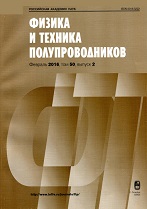|
This article is cited in 2 scientific papers (total in 2 papers)
Semiconductor structures, low-dimensional systems, quantum phenomena
Multilayer quantum well–dot InGaAs heterostructures in GaAs-based photovoltaic converters
S. A. Mintairovab, N. A. Kalyuzhnyyb, A. M. Nadtochiyacb, M. V. Maksimovab, V. N. Nevedomskiyb, L. A. Sokurabd, S. S. Ruvimove, M. Z. Shvartsb, A. E. Zhukova
a Federal State Budgetary Institution of Higher Education and Science Saint Petersburg National Research Academic University of the Russian Academy of Sciences, St. Petersburg
b Ioffe Institute, St. Petersburg
c Solar Dots Ltd., St. Petersburg, Russia
d Saint Petersburg Electrotechnical University "LETI"
e University of Notre Dame, Notre Dame, USA
Abstract:
GaAs photovoltaic converters containing quantum well-dot (QWD) heterostructures are studied. The QWD properties are intermediate between those of quantum wells (QWs) and quantum dots. The QWDs are obtained by the epitaxial deposition of In$_{0.4}$Ga$_{0.6}$As with a nominal thickness of 8 single layers by metal-organic vapor phase epitaxy. QWDs are a dense array of elastically strained islands that localize carriers in three directions and are formed by a local increase in the indium concentration and/ or InGaAs-layer thickness. There are two quantum-well levels of varied nature in structures with QWDs. These levels are manifested in the spectral characteristics of GaAs photovoltaic converters. A short-wavelength peak with a maximum at around 935 nm is associated with absorption in the residual QW, and the long-wavelength peak (1015–1030 nm) is due to absorption in the QWDs. Investigation by transmission electron microscopy demonstrates that an increase in the number of InGaAs layers leads to stronger elastic stresses, which, in turn, increases the carrier confinement energy in the QWDs and lead to a corresponding long-wavelength shift of the internal quantum efficiency spectrum.
Keywords:
Dot Quantum Wells (QWD), Photovoltaic Converters (PVC), InGaAs Heterostructures, InGaAs Layer, Short-wavelength Peak.
Received: 02.04.2018
Accepted: 10.04.2018
Citation:
S. A. Mintairov, N. A. Kalyuzhnyy, A. M. Nadtochiy, M. V. Maksimov, V. N. Nevedomskiy, L. A. Sokura, S. S. Ruvimov, M. Z. Shvarts, A. E. Zhukov, “Multilayer quantum well–dot InGaAs heterostructures in GaAs-based photovoltaic converters”, Fizika i Tekhnika Poluprovodnikov, 52:10 (2018), 1131–1136; Semiconductors, 52:10 (2018), 1249–1254
Linking options:
https://www.mathnet.ru/eng/phts5706 https://www.mathnet.ru/eng/phts/v52/i10/p1131
|


| Statistics & downloads: |
| Abstract page: | 43 | | Full-text PDF : | 27 |
|



 Contact us:
Contact us: Terms of Use
Terms of Use
 Registration to the website
Registration to the website Logotypes
Logotypes